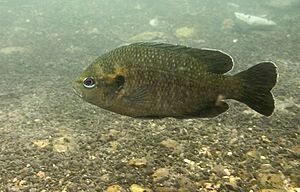Redspotted sunfish facts for kids
Quick facts for kids Redspotted sunfish |
|
|---|---|
 |
|
| Conservation status | |
| Scientific classification | |
| Synonyms | |
|
Lepiopomus miniatus D.S Jordan, 1877 |
The redspotted sunfish (Lepomis miniatus) is a cool freshwater fish found in the United States. People sometimes call it a stumpknocker. It's part of the sunfish family, called Centrarchidae. For a while, scientists thought it was just a type of spotted sunfish. But in 1992, a scientist named Warren showed that it's actually its own unique species!
Contents
Where Do Redspotted Sunfish Live?
The redspotted sunfish lives in freshwater across the Mississippi River Valley. You can find them as far north as Illinois and the Ohio River. They live west into Texas and Oklahoma's Red River. To the east, they reach the Chattahoochee River in Georgia.
Right now, the number of redspotted sunfish in the southern U.S. seems steady. However, their numbers have dropped a lot in Illinois. Illinois is at the northern edge of where these fish used to live.
In the past, redspotted sunfish were found all over Illinois. But by 2004, they were only in a few counties. Surveys in the mid-2000s found only two groups left in the whole state. One group was in a river that flows into the Illinois River. The other was in a river that flows into the Ohio River.
Scientists think several things might be causing this drop. One big reason could be the loss of wetlands. Wetlands are marshy areas that are the fish's natural home. Poor water quality or competition with new, non-native species might also be a problem.
What Does a Redspotted Sunfish Look Like?
The redspotted sunfish can grow up to about 6 inches (160 mm) long. It has a shiny, crescent-shaped mark under its eye. This mark is below its red or dark-colored iris.
Unlike the green sunfish, the redspotted sunfish does not have a dark spot on its back fin. Green sunfish also have bigger mouths. When male redspotted sunfish are ready to breed, their bellies turn red-orange. This color spreads up their sides in rows of scales. This special coloring helps tell them apart from other sunfish.
Redspotted sunfish also don't have dark spots at the bottom of their scales. This is different from spotted sunfish, which have these spots in rows. The redspotted sunfish has thin white or cream-colored edges on its back, bottom, and tail fins. It also has a dark flap behind its gill cover.
Sometimes, in places where redspotted sunfish and spotted sunfish live close together, they can look very similar. This happens in parts of Florida and western Georgia.
What Do Redspotted Sunfish Eat?
Redspotted sunfish mainly eat small creatures that live on the bottom of the water. When they are small, tiny animals called zooplankton make up most of their diet. As they get bigger, they start eating larger prey. Bigger redspotted sunfish mostly eat larger bugs and creatures from the bottom.
Many bigger fish, especially bass, like to eat redspotted sunfish. These sunfish usually live in shallow water with lots of plants. They prefer water that moves slowly.
Redspotted sunfish can also handle some salt in the water. This means you can find them in places where rivers meet the ocean, like bayous along the Gulf Coast. Even though they might compete for food with other sunfish or new species, it usually doesn't cause big problems. This is because redspotted sunfish can eat many different things. A bigger danger is when new species force them out of their favorite homes. This can make it easier for predators to catch them.
Redspotted Sunfish Life Cycle
Redspotted sunfish usually breed in late spring or early summer. The exact time depends on where they live. The male fish build nests in shallow, shady areas near the shore. A female redspotted sunfish lays about 2,000 eggs at a time.
These fish become adults and can have babies when they are about one to two years old. At this age, they are usually more than 2 inches (50–55 mm) long. Redspotted sunfish typically live for about five to six years. Six years is usually the oldest they get. Scientists are still learning how human changes affect their lives.
Helping Redspotted Sunfish Survive
The number of redspotted sunfish has dropped in many places. This is probably because swamps and lakes have been drained. Also, the water quality has gotten worse. Oil pollution has been named as a possible reason for fewer fish in the Wabash River in Illinois. There is also worry that a new fish, the Nile tilapia, could harm redspotted sunfish if they live in the same waters.
In 2008, the state of Illinois said the redspotted sunfish was an endangered species. This means it was in danger of disappearing completely. Luckily, many groups have been working to help them. Thanks to their efforts, the fish's status in Illinois improved to "threatened" in 2020. This means they are still at risk, but not as much as before.
The main groups helping these fish in Illinois are The Nature Conservancy, the Illinois Natural History Survey, and the Illinois Department of Natural Resources. They have moved some redspotted sunfish to two safe places. One is a special lake in the Emiquon National Wildlife Refuge near Havana, Illinois. The other is a pond in Allerton Park. These new groups of fish have had enough babies to help stock five more suitable places!


